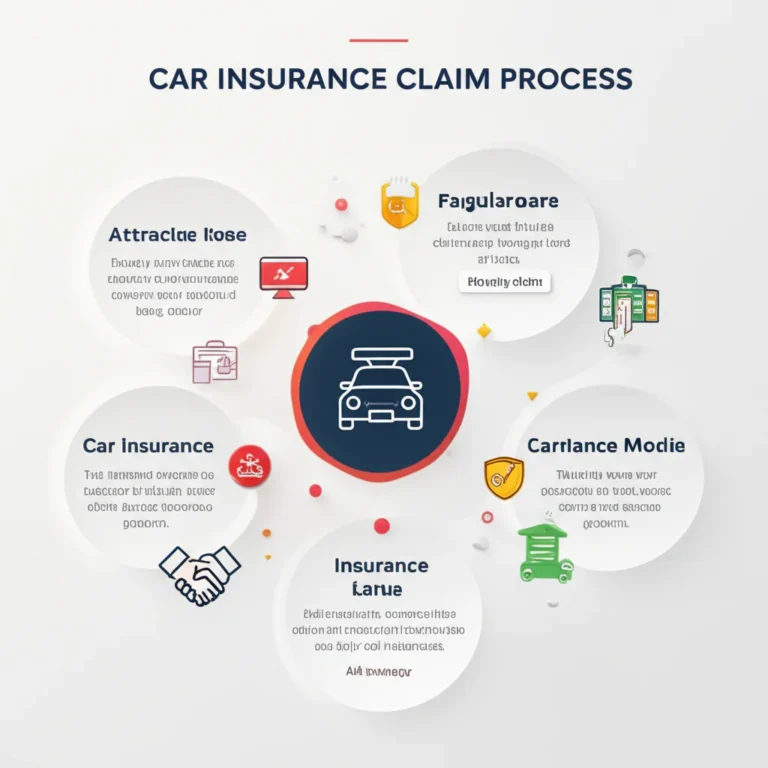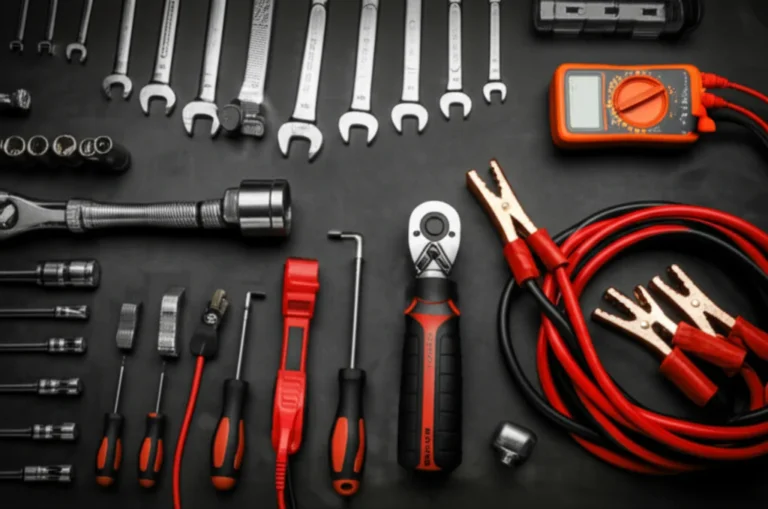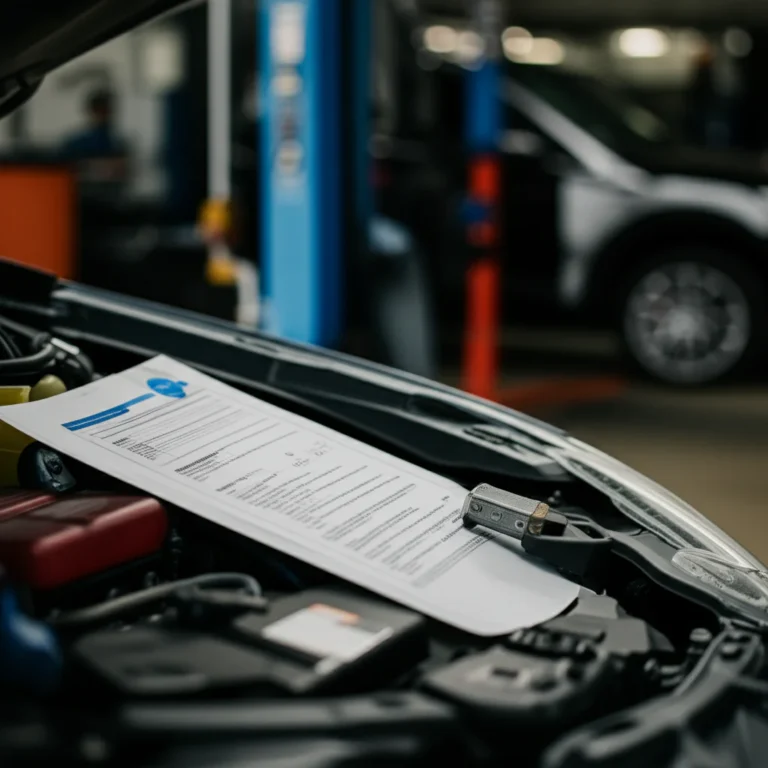Support our educational content for free when you purchase through links on our site. Learn more
How Do I File a Car Insurance Claim After an Accident? 🚗 (2025)
So, you’ve just survived the heart-stopping moment of a car accident—now what? Filing a car insurance claim might feel like stepping into a bureaucratic jungle, but don’t worry, we’ve got your back. In this comprehensive guide, we’ll walk you through every step of the claims process, from gathering evidence at the scene to negotiating with adjusters and even handling claim denials. Did you know that nearly 40% of claims involve minor damage, yet many drivers still botch the filing process and face delays? Stick around because later, we’ll share insider tips that can speed up your claim and help you avoid common pitfalls.
Whether you’re in Illinois, California, or anywhere else in the U.S., understanding the nuances of your policy and state laws can make a world of difference. Plus, we’ll reveal when it’s time to call a lawyer and how to use the latest apps to manage your claim like a pro. Ready to turn that fender bender into a smooth insurance win? Let’s dive in!
Key Takeaways
- Report your accident promptly and gather detailed evidence at the scene to strengthen your claim.
- Know your insurance coverage types (liability, collision, comprehensive) to understand what’s covered.
- Use insurer apps and online tools to file and track claims quickly and efficiently.
- Stay organized and keep records of all communications, estimates, and repairs.
- Don’t admit fault at the scene and be cautious with statements to insurers.
- If denied, appeal or seek legal advice to protect your rights and maximize your settlement.
With these essentials, you’ll navigate the claims process confidently and avoid costly mistakes. Ready to master your car insurance claim? Keep reading!
Table of Contents
- ⚡️ Quick Tips and Facts About Filing Car Insurance Claims
- 🚗 Understanding Car Insurance Claims: What You Need to Know
- 📋 Step-by-Step Guide: How to File a Car Insurance Claim After an Accident
- 🛠️ Common Challenges When Filing Claims and How to Overcome Them
- 💡 Insider Tips to Speed Up Your Car Insurance Claim Process
- 🌎 Filing a Car Insurance Claim After an Accident in Different States: What Changes?
- 📞 When and How to Contact a Lawyer or Claims Expert
- 🔍 Understanding Your Car Insurance Policy and Coverage Types
- 📱 Best Apps and Online Tools for Filing and Managing Claims
- 🧾 What to Do If Your Car Insurance Claim Is Denied
- 📊 Statistics and Trends in Car Insurance Claims After Accidents
- 🎯 How to Prevent Common Mistakes When Filing Claims
- 🔗 Recommended Links for Further Reading and Resources
- ❓ Frequently Asked Questions (FAQ) About Car Insurance Claims
- 📚 Reference Links and Credible Sources
- 🏁 Conclusion: Mastering the Art of Filing Your Car Insurance Claim
⚡️ Quick Tips and Facts About Filing Car Insurance Claims
Filing a car insurance claim after an accident can feel like navigating a maze blindfolded—but fear not! At Car Brands™, we’ve been through the twists and turns and are here to guide you with expert insights and practical tips. Before diving deep, here are some quick facts and tips to keep in your glovebox:
- Report the accident ASAP: The sooner you notify your insurer, the faster your claim can be processed. ⏰
- Gather evidence at the scene: Photos, witness contacts, police reports—these are your claim’s best friends. 📸👥
- Know your coverage: Understand your policy’s limits, deductibles, and what’s covered (liability, collision, uninsured motorist, etc.).
- You can file a claim with your insurer or the at-fault driver’s insurer—but the process and your rights differ.
- Don’t admit fault at the scene—let the investigation determine liability.
- Keep detailed records of all communications with insurance reps and repair shops.
- You have the right to choose your repair shop, but some insurers may recommend preferred shops.
- Rental car coverage depends on your policy—check if you have it before assuming you’re covered.
- If denied, don’t panic—there are appeals, mediation, and legal options.
For a comprehensive overview of car insurance basics, check out our car insurance guide.
🚗 Understanding Car Insurance Claims: What You Need to Know
Before you jump into filing a claim, it’s crucial to understand what a car insurance claim really is and how it fits into the bigger picture of your policy.
What Is a Car Insurance Claim?
A claim is a formal request to your insurance company to cover damages or losses resulting from an accident or other covered event. It triggers an investigation and, if approved, a payout or repair authorization.
First-Party vs. Third-Party Claims
- First-Party Claim: You file with your own insurer for damages to your vehicle or injuries, assuming you have the relevant coverage (collision, comprehensive, medical payments).
- Third-Party Claim: You file with the at-fault driver’s insurer to recover damages caused by their negligence.
Illinois’s Department of Insurance explains that third-party claims can be more complex since you don’t have a direct contract with the other driver’s insurer.
Why Understanding Fault Matters
Fault determines who pays. Some states use comparative negligence (Illinois allows recovery if you’re 50% or less at fault), while others are no-fault states where your insurer pays regardless of fault.
What Does Your Policy Cover?
- Liability: Covers damages you cause to others.
- Collision: Covers your vehicle’s damage from a collision.
- Comprehensive: Covers non-collision damage (theft, weather).
- Uninsured/Underinsured Motorist: Covers damages caused by drivers without adequate insurance.
Knowing your coverage helps you anticipate what claims you can file and what to expect.
📋 Step-by-Step Guide: How to File a Car Insurance Claim After an Accident
Ready to file your claim? Here’s the ultimate step-by-step walkthrough to get you from accident scene to claim settlement with confidence.
1. Assess the Accident Scene and Ensure Safety
Your first priority is safety:
- Move to a safe location if possible.
- Call 911 if anyone is injured.
- Stay calm and avoid confrontations.
2. Gather Essential Information and Evidence
This is your claim’s foundation. Collect:
- Names, phone numbers, and insurance details of all drivers involved.
- License plate numbers, vehicle makes, models, and colors.
- Contact info for passengers and witnesses.
- Photos of all vehicle damages, the accident scene, road conditions, and any traffic signs.
- Police report number and officer contact info if available.
Pro tip: Use your smartphone to capture everything—photos and videos can be invaluable later.
3. Notify Your Insurance Company Promptly
Call your insurer’s claims department or use their app to report the accident. Provide:
- Date, time, and location of the accident.
- Description of what happened (stick to facts).
- Information you gathered at the scene.
California’s Department of Insurance recommends reporting immediately to avoid delays. Some insurers require notification within 24-48 hours.
4. Fill Out the Claim Form Accurately
Your insurer will provide a claim form—fill it out carefully and truthfully. Avoid speculation or admitting fault. Attach copies of photos, police reports, and estimates.
5. Work with the Insurance Adjuster
An adjuster will be assigned to assess damages and liability. Be cooperative but cautious:
- Provide requested documents promptly.
- You’re not obligated to give recorded statements to the at-fault driver’s insurer (see #featured-video).
- Keep notes of all conversations and promises.
6. Get Your Vehicle Inspected and Repaired
The insurer may send an adjuster or ask you to get repair estimates. You have the right to choose your repair shop, but some insurers recommend preferred shops for convenience and guaranteed repairs.
7. Follow Up and Track Your Claim Status
Claims can take days to weeks. Stay proactive:
- Use your insurer’s online portal or app to check status.
- Follow up if you don’t hear back within promised timeframes.
- Keep all receipts and documents related to repairs, rentals, and medical bills.
🛠️ Common Challenges When Filing Claims and How to Overcome Them
Filing a claim isn’t always smooth sailing. Here are some hurdles you might face and how to tackle them:
| Challenge | What Happens | How to Overcome It |
|---|---|---|
| Claim Denial | Insurer rejects claim citing policy exclusions or lack of evidence. | Review denial letter carefully; appeal with additional evidence or consult a lawyer. |
| Delayed Processing | Claim lingers without updates. | Call your adjuster regularly; escalate to supervisors or state insurance department if needed. |
| Disputes Over Fault | Insurer blames you or reduces payout. | Provide police reports, witness statements; consider legal advice. |
| Low Settlement Offers | Insurer offers less than repair or medical costs. | Negotiate with documented estimates and bills; get a second opinion. |
| Repair Shop Conflicts | Insurer refuses to pay for your chosen shop’s estimate. | Understand your policy rights; negotiate or use recommended shops if budget is a concern. |
Remember: patience and persistence pay off. Don’t let insurers rush or intimidate you.
💡 Insider Tips to Speed Up Your Car Insurance Claim Process
Want to fast-track your claim? Here’s the insider scoop from our Car Brands™ team:
- Document everything immediately: The fresher the evidence, the stronger your claim.
- Use your insurer’s mobile app: Many companies like GEICO, State Farm, and Progressive offer apps that let you file claims, upload photos, and track progress instantly.
- Be honest but concise: Over-explaining or exaggerating can backfire. Stick to facts.
- Get multiple repair estimates: This can prevent lowball offers and give you leverage.
- Keep communication in writing: Email or app messages create a paper trail.
- Understand your deductible: Know how much you’ll pay out of pocket and factor that into your repair decisions.
- Ask about rental car coverage upfront: Avoid surprise bills by confirming if and how long you’re covered.
Following these tips can shave days or weeks off your claim timeline.
🌎 Filing a Car Insurance Claim After an Accident in Different States: What Changes?
If you’re wondering, “Does filing a claim differ by state?” the answer is a resounding yes—and it can be a bit of a patchwork quilt.
Variations in State Laws and Requirements
- Fault vs. No-Fault States: Some states like Florida and Michigan have no-fault systems where your insurer pays regardless of fault, limiting lawsuits. Others, like Illinois, use comparative negligence rules.
- Minimum Insurance Requirements: Illinois mandates minimum liability limits ($25,000 per person, $50,000 per accident for bodily injury, and $20,000 for property damage), while California requires $15,000/$30,000/$5,000 minimums.
- Claim Reporting Deadlines: Some states require you to report accidents to the DMV or insurer within specific timeframes (e.g., California requires DMV notification within 10 days if injuries or damage exceed $750).
- Rental Car Reimbursement Rules: Vary widely; some states require at-fault insurers to cover rental costs, others don’t.
Why This Matters to You
If you’re traveling or have recently moved, check your state’s Department of Insurance website for local rules. For example, California’s Insurance Department provides detailed guidance on claims and consumer rights.
📞 When and How to Contact a Lawyer or Claims Expert
Sometimes, the claims process gets complicated. When should you call in the pros?
Signs You Need Legal Help
- Serious injuries with long-term effects.
- Disputes over fault or low settlement offers.
- Claim denials without clear explanation.
- Insurance company acting in bad faith or delaying unreasonably.
- Lawsuit threats or actual legal action.
How a Lawyer Can Help
- Navigate complex insurance policies and state laws.
- Negotiate higher settlements.
- Represent you in court if needed.
- Protect your rights and interests.
We recommend consulting a specialized car accident attorney if your claim involves significant injuries or disputes. Many offer free initial consultations.
🔍 Understanding Your Car Insurance Policy and Coverage Types
Your policy is your roadmap through the claims process. Let’s break down the key coverage types and what they mean for your claim:
| Coverage Type | What It Covers | When It Applies |
|---|---|---|
| Liability | Damages you cause to others (bodily injury, property damage). | If you’re at fault in an accident. |
| Collision | Damage to your vehicle from a collision. | If you want your own car repaired regardless of fault. |
| Comprehensive | Damage from non-collision events (theft, vandalism, weather). | For covered non-accident damages. |
| Uninsured/Underinsured Motorist | Injuries or damages caused by drivers without sufficient insurance. | When the other driver lacks coverage. |
| Medical Payments | Medical expenses for you and passengers. | Regardless of fault, depending on policy. |
| Rental Reimbursement | Cost of rental car while your vehicle is being repaired. | If purchased as an add-on. |
Knowing these helps you understand which claims to file and what to expect in payouts.
📱 Best Apps and Online Tools for Filing and Managing Claims
In today’s digital age, your smartphone can be your best claims assistant! Here are some top apps and tools from major insurers:
| Insurer | App Features | Link to Download / Info |
|---|---|---|
| GEICO | File claims, upload photos, track status, roadside assistance. | GEICO App |
| State Farm | Claims reporting, digital ID cards, repair shop locator. | State Farm App |
| Progressive | Photo claim submission, claim status updates, rental car assistance. | Progressive App |
| Allstate | Claims filing, damage estimator, repair shop finder. | Allstate App |
Using these apps can reduce paperwork and speed up communication with your insurer.
🧾 What to Do If Your Car Insurance Claim Is Denied
A denied claim can feel like a punch to the gut, but it’s not the end of the road.
Common Reasons for Denial
- Insufficient evidence or documentation.
- Policy exclusions or lapsed coverage.
- Disputes over fault or cause of damage.
- Late reporting of the accident.
Steps to Take After Denial
- Request a detailed explanation in writing.
- Review your policy carefully to understand coverage and exclusions.
- Gather additional evidence such as photos, witness statements, or repair estimates.
- File an appeal with your insurer.
- Contact your state’s Department of Insurance for assistance or to file a complaint.
- Consider legal counsel if the denial seems unjust or unclear.
Remember, persistence and documentation are your best allies.
📊 Statistics and Trends in Car Insurance Claims After Accidents
To put things in perspective, here are some eye-opening stats from the Insurance Information Institute and other sources:
- Average claim payout for collision damage in 2022 was around $4,000.
- About 40% of claims involve minor damage (fender benders), while 10% involve serious injuries.
- Claims involving uninsured motorists account for roughly 13% of all claims.
- The average time to settle a claim ranges from 30 to 60 days, but complex injury claims can take months or years.
- Fraudulent claims cost insurers billions annually, leading to more scrutiny and delays.
Understanding these trends helps set realistic expectations for your claim.
🎯 How to Prevent Common Mistakes When Filing Claims
Avoid these pitfalls to keep your claim on the fast track:
- Don’t delay reporting the accident.
- Never admit fault at the scene or in your claim.
- Avoid giving recorded statements to the other driver’s insurer.
- Keep all receipts and records organized.
- Don’t settle too quickly without understanding your damages.
- Choose your repair shop wisely but know your rights.
- Be honest and thorough in your documentation.
These simple steps can save you headaches and money.
🔗 Recommended Links for Further Reading and Resources
- Illinois Department of Insurance: Filing Auto Claims
- California Department of Insurance: What to Do After an Accident
- Cutter Law: How to File an Insurance Claim After a California Car Accident
- Insurance Information Institute: Auto Insurance Claims
- Car Brands™ Car Insurance Guide
❓ Frequently Asked Questions (FAQ) About Car Insurance Claims

Q: How soon should I file a claim after an accident?
A: Ideally, within 24-48 hours. Some states and insurers have strict deadlines.
Q: Can I file a claim with the other driver’s insurance?
A: Yes, this is a third-party claim. However, your insurer can also assist, especially if you have collision coverage.
Q: Will filing a claim increase my premiums?
A: Possibly, depending on fault and your insurer’s policies.
Q: What if the other driver is uninsured?
A: Your uninsured motorist coverage can protect you if you have it.
Q: Do I have to use the repair shop recommended by my insurer?
A: No, but using their preferred shop may simplify the process.
Q: Can I negotiate the settlement amount?
A: Yes, especially if you have multiple repair estimates or medical bills.
📚 Reference Links and Credible Sources
- Illinois Department of Insurance: Filing an Auto Claim
- California Department of Insurance: After an Accident
- Insurance Information Institute: How Auto Insurance Claims Work
- Cutter Law: Filing Insurance Claims in California
- National Association of Insurance Commissioners: Auto Insurance
For a deeper dive into the nuances of claims and settlements, don’t miss the perspective shared in the featured video embedded earlier in this article. It reveals insider truths about claim numbers, adjusters, and the importance of documentation that can make or break your payout!
🏁 Conclusion: Mastering the Art of Filing Your Car Insurance Claim

Filing a car insurance claim after an accident might seem like a daunting quest through paperwork, phone calls, and negotiations—but with the right knowledge and approach, it’s more like a well-mapped road trip than a wild off-road adventure. From our deep dive at Car Brands™, the key takeaways are clear:
- Be prepared: Gather evidence and information at the scene.
- Act quickly: Notify your insurer ASAP to avoid delays or denials.
- Understand your policy: Know what coverage you have and what it means for your claim.
- Stay organized: Keep detailed records of all communications and documents.
- Be patient but persistent: Follow up regularly and don’t accept lowball offers without question.
- Seek expert help when needed: Lawyers and claims experts can be invaluable if things get complicated.
If you keep these principles in mind, you’ll navigate the claims process with confidence and maximize your chances of a fair settlement. Remember, every claim is unique, but the fundamentals remain the same. The mystery of “How do I file a car insurance claim after an accident?” is now solved—armed with facts, insider tips, and a roadmap from Car Brands™, you’re ready to hit the road to recovery.
🔗 Recommended Links for Shopping and Resources
If you’re looking to explore or switch insurers with robust claims support and user-friendly apps, here are some top brands we recommend:
- GEICO: TrueCar | Edmunds | GEICO Official Website
- State Farm: Auto Trader | Edmunds | State Farm Official Website
- Progressive: TrueCar | Edmunds | Progressive Official Website
- Allstate: Auto Trader | Edmunds | Allstate Official Website
❓ Frequently Asked Questions (FAQ) About Car Insurance Claims

What information do I need to provide when filing a car insurance claim?
When filing a claim, you’ll need to provide:
- Accident details: Date, time, location, and description of the accident.
- Other parties’ info: Names, contact info, insurance company and policy numbers, license plate numbers, and vehicle details.
- Witness information: Names and contact details if available.
- Police report: Number and officer’s contact info if a report was filed.
- Photos and videos: Damage to vehicles, accident scene, road conditions.
- Medical reports and bills: If injuries occurred.
- Repair estimates: From your chosen or insurer-recommended repair shops.
Providing complete and accurate information speeds up the claims process and reduces the risk of denial.
Read more about “How Can I Find the Cheapest Car Insurance? 9 Expert Tips for 2025 🚗”
How long do I have to file a car insurance claim after an accident?
The timeframe varies by state and insurer but generally:
- Notify your insurer within 24 to 48 hours for best results.
- Some states require reporting to the DMV or insurer within 10 days if damage or injuries exceed certain thresholds (e.g., California).
- Statutes of limitations for lawsuits related to claims can range from 2 to 5 years depending on the state.
Delaying notification can jeopardize your claim, so act promptly.
Read more about “What Types of Car Insurance Coverage Are Available? 🚗 (2025)”
Can I file a car insurance claim online or do I need to call?
✅ You can usually file claims online or via mobile apps with major insurers like GEICO, State Farm, Progressive, and Allstate. These platforms allow you to:
- Submit accident details.
- Upload photos and documents.
- Track claim status.
☎️ However, calling your insurer’s claims department is also an option and sometimes preferred for complex claims or if you want to speak directly with an adjuster.
What steps should I take immediately after a car accident before filing a claim?
Before filing your claim, make sure to:
- Ensure safety: Move to a safe spot and call emergency services if needed.
- Exchange information: Get driver, vehicle, and insurance details from all parties.
- Document the scene: Take photos/videos of damages, road conditions, and surroundings.
- Gather witness contacts.
- File a police report if required or recommended.
- Avoid admitting fault or making statements that could be used against you.
These steps build a strong foundation for your claim.
How does the claims process work with my car insurance company?
Once you file a claim:
- Claim intake: Your insurer records the claim and assigns an adjuster.
- Investigation: The adjuster reviews evidence, interviews involved parties, and assesses damages.
- Damage assessment: Vehicle inspection and repair estimates are obtained.
- Settlement offer: The insurer offers a payout based on coverage and damages.
- Repair and payment: Repairs are authorized, and payments made to you or repair shops.
- Follow-up: You may need to provide additional info or appeal if unsatisfied.
The process can take days to weeks depending on complexity.
What happens if the other driver is uninsured when I file a claim?
If the at-fault driver lacks insurance:
- Your Uninsured Motorist (UM) coverage (if you have it) can cover your medical bills and damages.
- If you don’t have UM coverage, you may need to pay out of pocket or pursue legal action.
- Some states require insurers to offer UM coverage; check your policy.
UM coverage is a critical safety net—don’t overlook it when shopping for insurance.
Read more about “Car Insurance Secrets: 6 Ways to Save Big! (2025) 💰”
Will filing a car insurance claim affect my premium rates?
It depends:
- At-fault claims often lead to premium increases.
- Not-at-fault claims may not affect rates, depending on insurer policies.
- Some insurers offer accident forgiveness programs.
- Multiple claims in a short period can raise premiums significantly.
Always weigh the cost of repairs versus potential premium hikes before filing small claims.
Read more about “Can I Get Car Insurance with a Bad Credit Score? 10 Tips for 2025 🚗”
📚 Reference Links and Credible Sources
- Illinois Department of Insurance: Filing an Auto Claim with Another’s Insurance Company
- California Department of Insurance: What to Do After an Accident
- Cutter Law: How to File an Insurance Claim After a California Car Accident
- Insurance Information Institute: How Auto Insurance Claims Work
- National Association of Insurance Commissioners: Auto Insurance Consumer Information
- GEICO Official Website: https://www.geico.com/
- State Farm Official Website: https://www.statefarm.com/
- Progressive Official Website: https://www.progressive.com/
- Allstate Official Website: https://www.allstate.com/
Ready to take control of your car insurance claim? With this guide and expert advice from Car Brands™, you’re equipped to turn a stressful accident into a smooth recovery journey. Safe driving and smart claiming! 🚗💨





